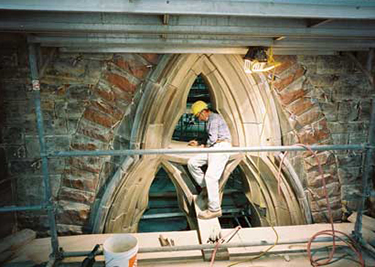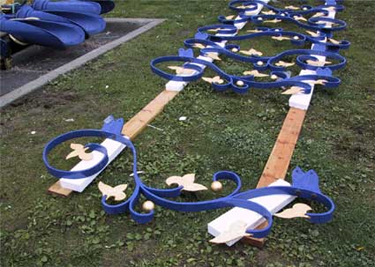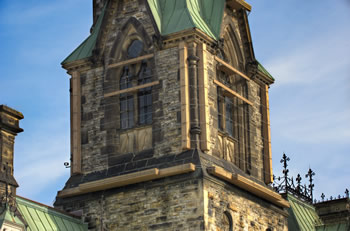How parliamentary buildings are rehabilitated

If you have visited or seen the Parliament Buildings recently, you will have noticed the scaffolding around the West Block. You may also have noticed the work being done on heritage buildings on nearby Wellington and Sparks Streets.
Many of these buildings are well over a hundred years old. Back then, these building were not built to withstand earthquakes. As well, their fine exterior stonework is crumbling, their roofs need repair and their windows need to be brought to current energy standards. Also, the buildings' plumbing, electrical, information technology and other systems need to be upgraded.
The Library of Parliament: An example of successful modern rehabilitation
Built in 1876, the Library of Parliament holds a special place in the history of Canada. It is the last remaining part of the original Centre Block and the only section to survive the fire of 1916.
By the end of the last century, the exterior of the Library of Parliament was seriously deteriorated. It was last rehabilitated over a half century ago following another fire in 1952.
In 2002, major work began to conserve, rehabilitate and upgrade the Library inside and out. This would ensure that it would remain an efficient and modern parliamentary resource. As well, it would remain a destination for visitors and an architectural wonder for future generations.
Work included:
- replacing the three copper roofs and the drainage systems;
- rehabilitating the decorative ironwork and the weathervane;
- removing and repairing 147 leaded glass windows and adding modern energy-efficient windows; and
- rehabilitating the stone masonry.

Restoring stone at Reading Room window, February 3, 2004. (Photo: Roy Grogan.)

Restored decorative ironwork that was reinstalled on lantern roof on October 14, 2005.

New copper roof and gutters (Photo: Roy Grogan.)
A multi-faceted rehabilitation
Many features of the parliamentary buildings are being upgraded, including the buildings' safety, heating and cooling systems. Ease of access and earthquake protection are also being improved. All this work is a huge task in any building—but especially so in these iconic buildings where we must preserve their heritage elements.
Public Services and Procurement Canada (PSPC) works closely with heritage architects and other specialists. Together, they ensure that the buildings are safe and meet the technical requirements of a 21st century democracy. The work must also respect the heritage nature of the buildings. The Library of Parliament is a testament to the work being carried out on Parliament Hill.
Earthquake-proofing

The parliamentary buildings are undergoing seismic assessments and upgrades
PSPC is studying how the parliamentary buildings respond to earthquakes. These seismic assessments and upgrades are difficult, especially because many of these buildings were designed and built before building codes existed.
As part of a planned rehabilitation, experts routinely assess the seismic resistance of the parliamentary buildings. To date, all of their assessments have confirmed that the buildings are safe to occupy, even after recent earthquakes.
Experts also perform yearly assessments to ensure that the buildings can be evacuated safely in the event of a major earthquake. If a building is not up to the standards in the National Building Code of Canada, upgrades are automatically undertaken when the building is slated for major renovation.
In 2007, PSPC collaborated with Canadian universities to study the effects of ground shaking on walls like those found on Parliament Hill. The research provided important findings on how these heritage stone walls will react to earthquakes. The research also provides information to conservationists, engineers and stonemasons. This way, these experts can better preserve important heritage structures across Canada and around the world. Expert recommendations from our ongoing seismic upgrade work are also used in upcoming projects and designs. These recommendations ensure that our parliamentary buildings will last for centuries more.
Laser cleaning
Laser technology offers a 21st-century solution for a medieval craft. Using a highly focused, powerful light source, the stonemasons simply vaporize the dirt without any physical contact. Unlike the wet abrasive methods that require a carefully sequenced approach so that chemical and water waste does not flow over previously cleaned stones, laser cleaning allows larger surfaces to be cleaned uniformly, at any time and at any location. It is a convenient, flexible and vastly superior approach, and now a standard tool in the stonemason’s kit right beside the traditional trowel.
Transcript of the laser cleaning
Start of clip
(Construction sounds resonate in the background)
Medium shot of a man holding a laser cleaning tool. He is wearing a hard hat, safety glasses and a bright orange safety vest.
Close-up of the laser cleaning tool. As the man moves the devices upwards and downwards, a dark film of dirt covering the stone disappears.
Close-up of the tool cleaning a second stone. The laser cleaning tool is then deactivated and pulled away leaving half of the stone clean.
(Cut to black.)
Canada Wordmark
End of clip
MP4 format ( 3.5M B)